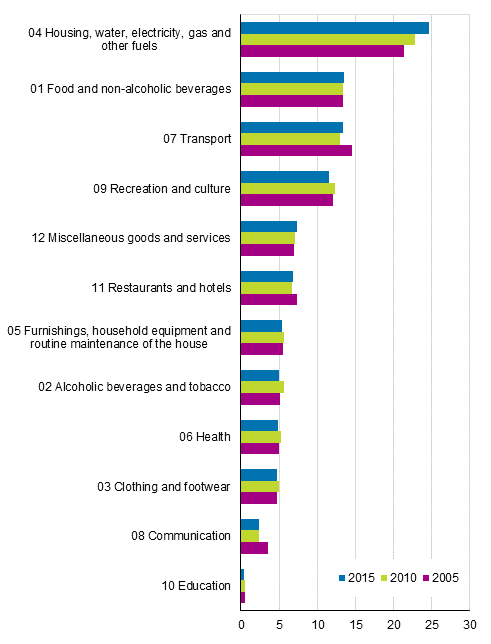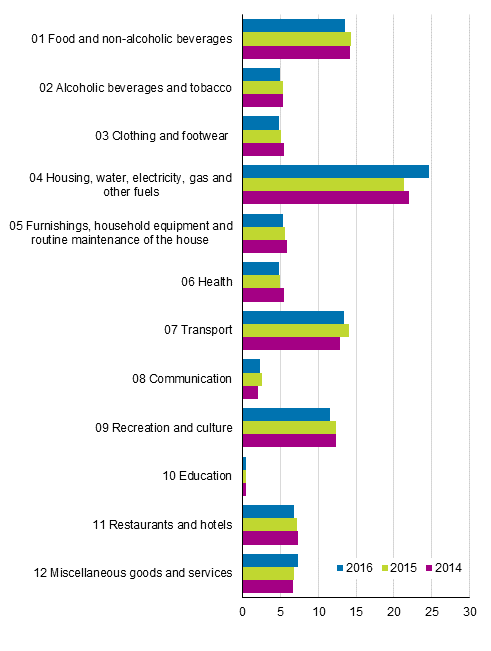Base year of the Consumer Price Index was renewed
Statistics Finland has made revisions to the Consumer Price Index. The base year was chosen to be 2015=100 so that the national Consumer Price Index would be in line with the Harmonised Index of Consumer Prices produced in the EU Member States. Previously, the Consumer Price Index was revised at five-year intervals, so the now revised Consumer Price Index series is also accordant with this tradition. At the same time, the weight structure of the Index and the basket of commodities included in the price monitoring have been updated to correspond with consumption in the new base year.
After the revision, the commodity basket includes 476 products and services. The Index aims to monitor development in the prices of commodities that are as representative as possible, so new commodities are added to the commodity basket and commodities whose weight is under one per mil of total consumption are removed from the basket. New commodities in the Consumer Price Index are portion packed cereal flakes, frozen puff pastry, soya drink, olive oil, lining panel, electrical installation service, painting service, blender, broadband TV service, and home meal service. The list of removed commodities includes for example wheat bread, baguette, cooked ham, ready meal portion, baby's outdoor overall, coffee table, satellite navigator, stereo, and badminton racket. The total number of removed commodities was 24.
Commodity classification used in the Consumer Price Index was renewed
At the beginning of 2016, an updated commodity classification was taken into use in the Consumer Price Index (eCOICOP, European Classification of Individual Consumption According to Purpose). The commodity classification is based on the UN's Classification of Individual Consumption According to Purpose, from which a commodity classification was formed for the use of the EU Member States. The new classification separates products and services into commodity groups more precisely than before. At the same time, the commodity classification expanded from the 4-digit level to the 5-digit level. The classification now adopted in the Consumer Price Index has been confirmed by a European Commission Regulation.
In addition to the overall index, the EU classification covers four classification levels, and additionally, two sub-levels have been added for national needs. The eCOICOP commodity classification is also used in purchasing power parity, the Household Budget Survey and national accounts (starting from 2018). The introduction of the eCOICOP classification brings specifications to the sub-division of fresh and frozen food, new service items for dwelling maintenance and repair, and new repair services for several commodity groups. Part of the changes related to the commodity classification can be included in the index only when more accurate commodity-specific information is available from national accounts for defining the weight of the commodity in question. The earlier classification codes of several commodities had to be updated in connection with the introduction of the commodity classification to correspond to the new classification.
Weight structure of the Consumer Price Index was updated
The weight structure of the Consumer Price Index 2015=100 is based on national accounts data on private consumption. The data are updated annually. Previously (before 2013), the weight structure of the Consumer Price Index was updated every five years. The last big scheduled update was made at the beginning of 2011, when approximately 15 per cent of the commodities were changed. New commodities were added to the commodity selection of 2016 and commodities whose consumption was under one per mil of total consumption were removed from it.
Other sources such as the Household Budget Survey conducted at five-year intervals at Statistics Finland, statistical data produced by other statistics, the Bank of Finland's statistical data, and sales data of central associations and organisations are also used for the definition of commodity-specific sub-division. The weight structure for 2016 corresponds to the value of private consumption in 2015, which was around EUR 99.4 billion. In the previous base year of 2010, the value of consumption was EUR 83.3 billion, and in 2005, respectively, EUR 70.4 billion.
Figure 1. Weight structure comparison between Consumer Price Index series, per cent

The weight structure of the three base year series are compared in the figure above by commodity group level. The biggest weight values in the past ten years have been Housing, water, electricity, gas and other fuels, and Food and non-alcoholic beverages.
The weights of the Consumer Price Index are composed of the value of goods and services bought by households in Finland. Households also include the consumption of tourists in Finland and institutional households. The concept of private consumption in the Consumer Price Index differs from the concepts used in national accounts and the Household Budget Survey and its coverage is also different. The price development of representative commodities is monitored in the Index. With the help of annually updated commodities and weights, more timely representation of commodities in the Index is ensured.Figure 2. Weight structure comparison of Consumer Price Index 2015=100, per cent

The biggest changes in the weight structure of the Index compared to the year before are in the commodity groups of housing and other financial services. For housing, the value weight of the 04.6.2 Renovations item quadrupled due to the revisions to the data of the statistics on renovation building. For other financial services, the value weight of the 12.6.2.1.1 Bank service charges item was raised based on more accurate financial statements data of financial corporations. Changes in the prices of commodities in this group have now more effect on the overall index of the Consumer Price Index than before.
Revision does not break all series
Consumer price indices that are reviewed at set intervals of years are suitable for short-term examinations. The Cost-of-living Index 1951:10=100 is a long time series calculated by chaining with the latest Consumer Price Index (currently Consumer Price Index 2015=100) and its development, therefore, follows the Consumer Price Index.
Many rents, such as those on dwellings, business premises or land, are usually tied to the Cost-of-living Index. From the user’s point of view, the Cost-of-living Index is the most practical, because index revisions do not interrupt the series, and the point figures of the Cost-of-living Index are published monthly at the same time as the Consumer Price Index.
The series of previous base years, such as 2005=100 and 2010=100, are chained forwards by the monthly change of the Consumer Price Index 2015=100. The statistics also produce special indices as chargeable information services.
Base year of the Harmonised Index of Consumer prices was renewed
Statistics Finland has also revised the weight structure of the Harmonised Index of Consumer Prices calculated for Eurostat, the Statistical Office of the European Communities. In the same connection, the base year was changed into 2015=100 in accordance with the Regulation updated by the European Commission.
The Harmonised Indices of Consumer Prices are primarily used in price comparisons between the EU countries. The European Central Bank uses the Harmonised Index of Consumer Prices as the measure of inflation in its monetary policy.
Finland's Harmonised Index of Consumer Prices is based on the same weight and price data as the national Consumer Price Index, but its commodity selection is narrower: it excludes owner-occupancy, games of chance, interests and tax-like payments. The Harmonised Index of Consumer Prices covers 85 per cent of the national Index. Before the update of the 2016 weight structure, the coverage of the Harmonised Index of Consumer Prices was close to 90 per cent. The reason for the decrease in coverage is the risen weight share of renovations in the Consumer Price Index, which item is not taken into consideration in the Harmonised Index of Consumer Prices.
Table 1. Consumption items removed from the Harmonised Index of Consumer Prices and their weights in the Consumer Price Index 2015=100 in 2016
| COICOP | Commodity/group | Weight in the CPI, o/o |
| 04.6 | Owner-occupied housing | 10.76 |
| 07.2.4.2.1.1 | Vehicle tax | 1.27 |
| 09.4.3.0.1.1 | Games of chance | 1.93 |
| 12.5.2.0.1.2 | Premium for fire insurance on detached houses | 0.08 |
| 12.6.2.1.1.2 | Interests on consumer credits | 1.19 |
| Items removed from HICP, total | 15.23 | |
Source: Consumer Price Index, Statistics Finland
Inquiries: Ilkka Lehtinen 029 551 3478, Kristiina Nieminen 029 551 2957, khi@stat.fi
Director in charge: Ville Vertanen
Updated 19.2.2016
Official Statistics of Finland (OSF):
Consumer price index [e-publication].
ISSN=1799-0254. January 2016,
Base year of the Consumer Price Index was renewed
. Helsinki: Statistics Finland [referred: 26.4.2025].
Access method: http://stat.fi/til/khi/2016/01/khi_2016_01_2016-02-19_kat_001_en.html

